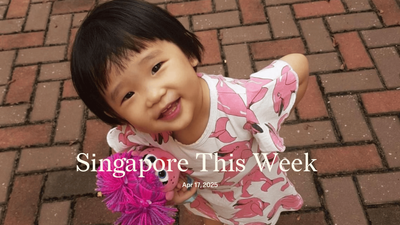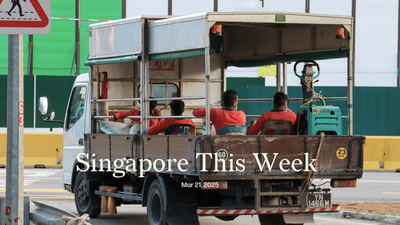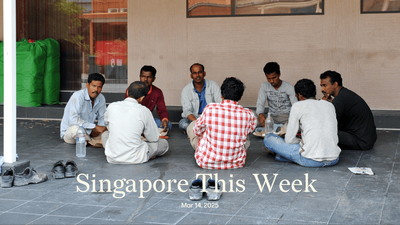Politics: The government risks turning Pritam Singh into a martyr
Did Pritam Singh prod Raeesah Khan to lie or tell the truth to Parliament? That is the crux of the matter in the latest case to embroil Singh, the Workers’ Party (WP) chief and leader of the opposition. On August 3rd 2021, Khan, then his fellow WP member of Parliament (MP), fabricated a story in Parliament. She claimed to have gone to the police station with a sexual assault survivor, who was allegedly met by demeaning comments from an officer. Four days later, she told Singh she’d lied. But she only came clean to Parliament almost three months later, saying she’d heard the anecdote in a survivor support group.
Why the delay? In the parliamentary investigation by the Committee of Privileges, after Khan had resigned, she asserted that Singh had told her to take her lie “to the grave”. Singh denied this, claiming that the delay was because he wanted her to first speak to her parents. This He-said-She-said prompted the committee to refer Singh to the Attorney-General’s Chambers (AGC), which this week charged him with two counts of lying. (The AGC declined to pursue a separate complaint against Faisal Manap, another WP MP.)
Singh pleaded not guilty and claimed trial. The ruling People’s Action Party (PAP) has said it will not push Singh to leave Parliament while the proceedings are ongoing. And unlike Donald Trump, whose presidential bid could be derailed in the American courts, Singh, even if found guilty, is unlikely to be forced out of Parliament, given the quantum of the suggested fines, according to law professor Eugene Tan.
Recall that allegations about financial improprieties at WP town councils first emerged in 2013. Singh has effectively now had accusations collectively hanging over him for over a decade. The PAP probably hopes that these add friction to the WP machinery, but their leaders seem to brush it off. “When I first entered politics some years ago now, I was under no illusion as to the challenges that lay ahead in building a more balanced and democratic political system in Singapore,” Singh said in a media statement this week, before a jolly post about joining devotees for iftar at the En-Naeem Mosque.
The PAP might also hope that Singh’s reputation is smeared amongst undecided voters, though the opposite may be true. The AGC’s independence is beyond question. But less informed voters might make the mistake of thinking that it’s helping the PAP given the timing: the next general election (GE) must be called by November 2025. It will be important for the institutions to put this beyond doubt. The town council saga didn’t bother voters too much at the 2015 GE. This latest charge might benefit the WP if it garners their sympathy.
Society: Gender equality isn’t a ‘zero-sum’ game
“[Do] what you want la but stop yapping all that bullshit about gender equality please,” said a Redditor in response to a global survey by Ipsos on perceptions of gender equality in 31 countries. Of the 500 Singaporeans aged 21-74 surveyed, 57 percent of men agree with the statement “we have gone so far in promoting women’s equality that we are discriminating against men.” Other notable, and somewhat disheartening, findings include: 58 percent of Singaporeans believe men are expected to do too much to support gender equality; 62 percent of Singaporeans believe the country has gone far enough in giving women equal rights with men; and 48 percent of Singaporeans were scared to speak up and advocate the rights of women over fear of what might happen to them.
The Association of Women for Action and Research (AWARE), a local women’s rights advocacy group, said that the Ipsos survey reflects a deep-rooted resistance to equality. “The results expose a persistent misconception: that equality is a zero-sum game where gains for women come at the expense of men,” they wrote on social media. In other online discussions, conversations seem to continually circle back to National Service (NS)—“If women cannot admit that NS is a massive liability for men…then there is simply nothing that men can or should do for [sic] women equality,” reads one comment. More optimistic readers have pointed out that 63 percent and 54 percent of Singaporeans expressed no preference for the gender of political leaders and bosses, respectively.
But Ipsos highlighted survey data which reflects that Singaporeans generally believe male and female politicians are better at addressing different national concerns. For example, men are more adept at fighting crime and defending national security, while women are more well-suited to tackle problems related to social inequality and LGBTQ issues. This “tendency to associate certain roles and capabilities with specific genders” reveals a “potential unconscious bias in our society,” according to Ipsos. Could Ipsos’s survey results be related to the emergence of men’s rights activists, and perhaps indicative of the general backlash that has historically risen in response to social justice movements (eg women’s suffrage, Black Lives Matter)? One thing is certain: we all suffer under the patriarchy. Although there’s no clear path towards gender equality, refraining from pitting women and men against each other would be a good start.
Some further reading: “Boys will be boys? Masculinity in Singapore’s National Service” by Athena Thang for Jom.
Society: Singapore, we’ve got trust issues
Trust is hard-earned and easily lost. So the fact that the government remains the most trusted institution in Singapore—more than NGOs, businesses and the media—will surely reassure the PAP, especially in the wake of last year’s scandals. This was revealed in the 2024 Edelman Trust Barometer report, a survey conducted last November by Edelman, a public relations firm, of more than 32,000 respondents in 28 countries, including 1,150 people here. Singapore along with Indonesia, Malaysia and Thailand are among the top 10 most trusting nations globally, with Japan and the UK being the least trusting. But, despite an overall trust index of 67 percent in Singapore, one in two surveyed still worry that business and government leaders, as well as journalists and reporters, will mislead them by saying things that they knew were “false or gross exaggerations”.
Like in other developed countries, economic and existential fears persist: 93 percent of Singaporean respondents are concerned about job loss; 80 percent about hackers; and around seven out of 10 about inflation, climate change and nuclear war. Globally, financial optimism has “collapsed”. Widening inequalities have led to a growing trust gap between high- and low-income earners—the former being more trusting. In Singapore, just 36 percent of respondents think that their lives will improve—a decline of seven percentage points from 2023 and an all-time low in optimism, said Edelman. This year’s annual survey—its 24th edition—focused on society’s trust in innovation. In Singapore, the government is the most trusted institution to introduce innovations that are safe, understood by the public, beneficial and accessible. But when institutions mismanage innovation, more than half believe that technology and society are leaving them behind.
Ahead of a GE, political leaders will do well to build trust in the electorate by improving transparency and accountability. In adapting to an environment of “greater contestation and scrutiny”, Peter Ho, a former civil servant, suggested that there was perhaps a need for more consultation between the public and people sectors. But public trust has a “social” dimension too, Ho noted. Deepening trust among different communities will help to strengthen the nation’s social fabric, something that 46 percent of respondents believe has “grown too weak to serve as a foundation for unity and common purpose.” Singapore isn’t immune to the forces, technological and others, that seem to be pulling people apart.
History weekly by Faris Joraimi
A smorgasbord of opinions has been presented through the mainstream media on the Singapore Indoor Stadium’s (SIS) uncertain future. A report earlier this month said a new “best in class globally” arena will “replace” it, before last week’s news, which said the new venue will be “adjacent” to the current stadium instead. Heritage consultants, photographers, and scholars of urbanism weighed in on the SIS’s importance to our architectural history. Meanwhile, sports officials pointed out how its features are falling behind the demands of hosting international events that require more sophisticated infrastructure. It was surprising to learn that the elegant landmark, where I watched three editions of “Disney on Ice”, was designed by Kenzo Tange, a world-famous Japanese architect behind iconic public buildings including the Hiroshima Peace Memorial Museum (1955) and Tokyo’s Yoyogi National Gymnasium (1964). The latter’s sloping metallic roof resembles that of the SIS.
I suppose the best civic buildings make room for all kinds of crowds. As a site of mass commemoration and collective memory-making, it’s also a type of civic space that’s extensively used by the crowd, who make it meaningful by participating in its rituals. The old Kallang Stadium’s demolition generated such a nostalgic outpour, over its National Day Parades and legendary football matches. Its Colosseum-like embrace enhanced the visual and sensory effect of membership in a large social body. In our neighbouring countries, stadiums were also political theatres, with Tunku Abdul Rahman’s independence proclamation televised from the Stadium Merdeka in 1957. Jakarta’s Gelora Bung Karno Stadium hosted the 1962 Asian Games, a point of pride for fledgling Indonesia. Both are still around, giving the past a material surface. Without the “grand dame” of Kallang, and the barely 40-year-old Indoor Stadium in mid-life crisis, our crowds and rituals—our history—seem to lack a lasting home.
Arts: The many hats of Eugene Tan
If it wasn’t enough to be director of the Singapore Art Museum (SAM) and the National Gallery Singapore (NGS)—Eugene Tan has ascended to chief executive of both institutions. He’s now also head of the national Visual Arts Cluster, which in addition to the museum and gallery includes the Singapore Tyler Print Institute. The most high-profile double-hatting stint in the local arts sector prior to Tan’s hat-trick was when Benson Puah headed both the National Arts Council (NAC) from 2009-2013 and Esplanade from 1998-2018. Despite Puah’s insistence that there was good governance, clear oversight and no conflict of interest (“there’s no direct relationship between NAC and Esplanade,” the arts administration stalwart told TODAY), these murmurings never quite went away. As it is, satirical memes around Tan’s triple appointment have been making the rounds.
Favoured picks for these top-tier arts administration jobs tend to be high-flyers in the business or hospitality sectors, or career civil servants. These include outgoing NGS head Chong Siak Ching and former arts council chief Kathy Lai. It hasn’t been easy for these massive, state-funded arts institutions to attract and retain artists at the top; one of the rare SAM directors to buck the trend was artist Susie Lingham, who spent just over two years at the helm before departing “to pursue personal projects”. Tan has asserted his staying power as director of the gallery since 2013 and of the museum since 2019, and has been steadily concentrating this institutional power, climbing the global ranks of ArtReview’s “Power 100” over the past decade and reaching a career high of #29 last year. The prominent art magazine described him as “the consummate diplomat”; the appointed person needs to be someone that all stakeholders approve of, including the culture ministry, the gallery’s and museum’s boards, and chairmen of both institutions. It’s true that that the smooth operator “doesn’t often ruffle feathers”: he’s secured crowd-pleasing blockbusters (Yayoi Kusama), kept things intellectually and aesthetically on-trend (“Tropical: Stories from Southeast Asia and Latin America” and “Ho Tzu Nyen: Time and the Tiger”), and generally—as the “diplomat” is wont to do—erred on the side of political pleaser rather than provocateur.
The job-sharing in these rarefied positions reflects a broader problem in Singapore’s arts industry. It’s not just a small pool of leadership talent and an even smaller appetite for artistic risk. But nurturing a more diverse selection of candidates with a well-calibrated mix of business acumen and arts knowledge requires capability development much earlier on, and for much longer. One thing Puah got right was cultivating his successor years in advance; Yvonne Tham’s smooth takeover of Esplanade and her popularity in the industry is certainly a feather in both of their caps. Let’s see if Tan can do the same.
Arts: Goodbye, Gillman Barracks?
Are there any permanent homes in Singapore? Artists and arts groups have all but reconciled themselves to being itinerant inhabitants of arts-designated spaces across the island. The next casualty of renewal could be Gillman Barracks: repurposed as a lifestyle cluster in the 1990s, given a S$10m facelift as an arts district just over 10 years ago, and now being studied as a potential site for both private and public housing. Desmond Lee, minister for national development, announced this possibility in Parliament on March 5th. The forested colonial-era barracks have been popular among artsgoers during festival periods, but haven’t had the same catchment otherwise. The Straits Times reported that five out of 17 art galleries “decided against renewing their leases [in 2015], citing poor sales and low visitorship.” While the existing galleries and F&B outlets are welcome to remain until their rentals expire in 2030, many are in tenancy purgatory. Audrey Yeo, founder of gallery Yeo Workshop, told the national newspaper: “We hope for the support of the authorities to find a solution for us, considering we are at the mercy of landlords to thrive.”
It’s also arts tenancy turnover time here, and the NAC has opened up applications for the arts spaces it manages, including a stretch of conservation shophouses along Waterloo Street and the Telok Kurau Studios, Singapore’s first visual arts housing project. While the council’s Arts Housing and Arts Centre Schemes feature attractive subsidised rental, the former features a one-year term and the latter carries a maximum tenure of three terms of three years each (nine years in total, if you’re lucky). This means those occupying these spaces frequently fret over tenancy reapplications and renewal—even flagship companies such as The Theatre Practice, which currently rents a Waterloo shophouse. Arts housing and placemaking is up for perennial debate in Singapore. Artists here have often chafed against the state’s curatorial approach, a tug of war between wanting to house a diverse range of artists and groups, while also ending up prescribing and pruning their use of a space. Hoe Su Fern, arts management professor, analysed this: “While state policies and programmes such as the Arts Housing Policy are crucial to arts development and practice, state assistance is also a double-edged sword as artists and arts groups remain vulnerable to bureaucratic intervention and have to accept the terms and conditions dictated by the state.” The manicured garden-city approach can be difficult to uproot.
Tech: Strengthening the university innovation ecosystem
The National University of Singapore’s (NUS) commitment of S$20m towards the development and commercialisation of deeptech research signifies a major stride in translating advanced research into viable, market-ready innovations. This move is particularly impactful in critical areas such as climate change and food security. By earmarking half of these funds to assist faculty members and researchers in transforming their deeptech projects into commercial products, NUS is nurturing a culture of innovation and entrepreneurship within an academic setting. Besides supporting individual projects, NUS has allocated the rest of the funds to bolster its Graduate Research Innovation Programme. This initiative plays a pivotal role in guiding and supporting prospective entrepreneurs in launching businesses rooted in deeptech innovations, fostering a conducive ecosystem for research-driven entrepreneurship. One notable beneficiary of NUS’s supportive framework is HiveBotics, which gained recognition from JTC’s LaunchPad initiative, and exemplifies the kind of deeptech innovation that stands to benefit from NUS’s recent funding announcement. Its robots automate toilet cleaning, demonstrating the practical application of deeptech in addressing issues like manpower shortages and rising labour costs, concerns particularly pressing in developed economies. The previous collaboration between NUS, Nanyang Technological University, and Temasek on a US$55m (S$73.5m) pilot programme for deeptech start-ups, along with Temasek’s annual commitment of US$740m (S$989.3m) to deeptech investments, underscores the collective resolve to cement Singapore as a hub for deeptech innovation—helping our country do its part to address global challenges.
Tech: The clock goes TikTok
The recent passage of a bill by the US House of Representatives, aiming to compel ByteDance to divest TikTok’s US assets within six months or face a ban, represents a significant escalation in the US-China tech dispute. The Protecting Americans from Foreign Adversary Controlled Applications Act garnered overwhelming support in the House, moving forward with a 352 to 65 vote. However, its future hinges on Senate approval, a hurdle that has hitherto hindered similar efforts. This legislative move underscores deepening concerns among US lawmakers about the Chinese government’s influence on TikTok, which has a substantial user base of 170m in the US. ByteDance’s CEO, Shou Zi Chew, has vehemently denied any links between TikTok and the Chinese Communist Party, and has vowed to utilise all legal means to contest a potential ban. The US president’s readiness to sign the bill into law, should it pass the Senate, will be a critical juncture in the ongoing tensions between China and the US, with potential political ramifications for the upcoming presidential elections. After all, Americans are split on a TikTok ban, with 31 percent of American adults favouring a nationwide ban while 35 percent oppose it. The US isn’t alone in cracking down on the social media giant. Globally, there have been varied responses to TikTok’s operations, with countries like Indonesia imposing restrictions, though often with pathways to resolution. The case of Indonesia’s TikTok Shop, for example, illustrates a negotiation outcome, where TikTok eventually acquired a majority stake in local e-commerce player Tokopedia. This reflects the complex landscape of international tech governance in which companies must navigate larger geopolitical conflicts arising from their home countries and customer markets. Everyone is now watching whether the clock runs out for TikTok in the US, in the next six months.
If you enjoy Jom’s work, do get a paid subscription today to support independent journalism in Singapore.








